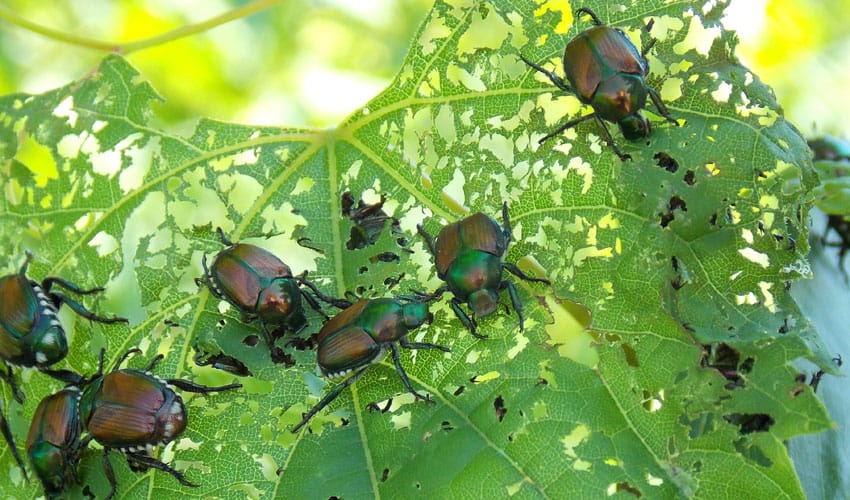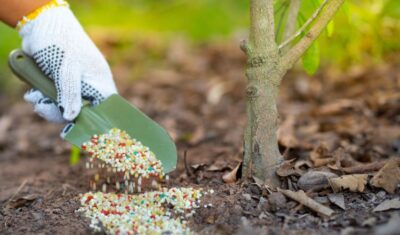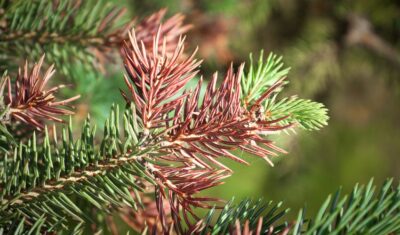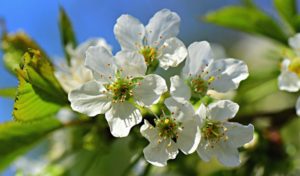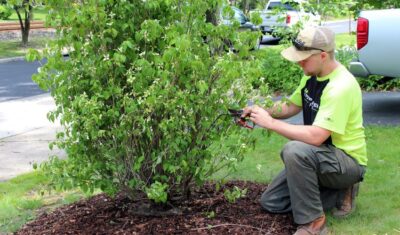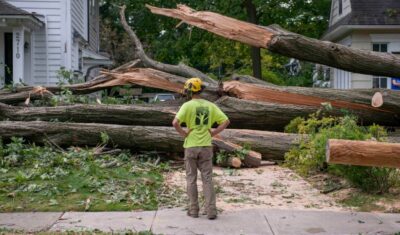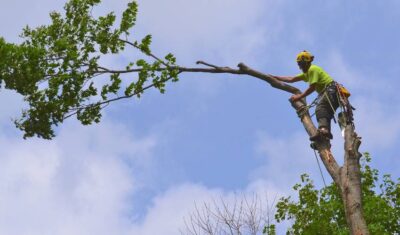While lace can be an attractive addition to clothing, it’s not something you want to spot on the leaves of your trees or shrubs. One of the most common reasons for that lace-like appearance is damage caused by Japanese beetles feeding on your plants. Starting in late June, these voracious pests can quickly skeletonize an entire shrub, as well as decimate flowers (roses are a favorite) and ripe fruit.
And these pests don’t just damage trees and shrubs. During the earlier (pupal) stage of their lives, Japanese beetle grubs live underground, where they feast on the roots of healthy and well-watered turf grasses. If your lawn is turning brown in spots and feels spongy, but you know that it’s getting enough water, you may have a grub infestation.
This article describes how to identify Japanese beetles and what you can do to control and prevent infestations in your northeast Ohio yard or property.
What do Japanese Beetles Look Like?
As adults, Japanese beetles (Popillia japonica) are easy to recognize. They’re about ½-inch long, with a metallic green back. They have copper colored wings and white dots around the edges of their bodies. These pests tend to feed in groups (making them even easier to spot), starting at the top of a plant and working downward.
You’re not likely to see Japanese beetle grubs unless you’re looking for them. But if you dig up a piece of sod, you might spot 3/4-inch long brown-headed, white grubs scattered throughout the soil just below the grass roots.
When Do They Emerge?
In northeast Ohio, adult Japanese beetles emerge from the soil and immediately start feeding on the closest palatable plant material in late June and throughout July.
During this time, the Japanese beetles are not only feeding on and destroying leaves, fruit, and flowers, they are also mating and depositing eggs into the nearby soil. One female lays up to 5 eggs at a time, but over the next few weeks (up until the first frost) they can lay 40 to 60 eggs.
Within a few days (depending on how warm the soil is), these eggs will have hatched into grubs and begun burrowing deeper into the soil.
Japanese beetles hibernate as grubs over the winter. They dig down into the soil until the ground is above 25 degrees Fahrenheit, usually about 4 to 8 inches below the surface.
Once the soil begins to warm again in the spring, the cycle continues with the grubs moving closer to the surface, and emerging as adults in late June through July.
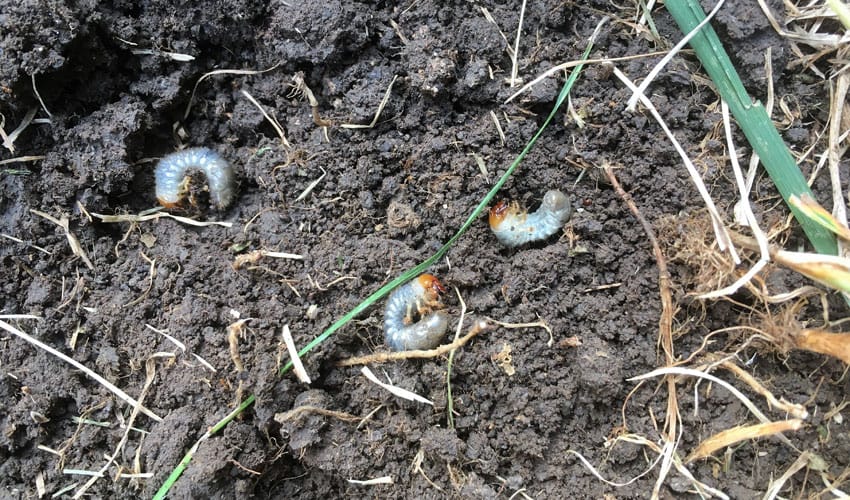
Japanese beetle grubs can be found just below grass roots.
Ways to Control Japanese Beetles
If the leaves of your trees or plants are skeletonized (resembling lace), it’s probably caused by Japanese beetles. While there’s no perfect method to control or eliminate Japanese beetles, you do have a few options.
Netting and row covers can protect some smaller plants and shrubs from Japanese beetles.
Hand picking or knocking beetles off plants is a good option (but maybe not if you’re squeamish). If you’ve spotted adult beetles on your plants, simply pick them off (or gently shake them off) and place them in a bucket of soapy water where they will drown. Japanese beetles get more active as the sun gets warmer, so it’s best to do this task early in the morning.
There are Japanese beetle traps on the market that attract adult beetles with a scent they like. However, we’ve found that these tend to attract more beetles to your yard and do little to reduce the overall population. As a result, we don’t recommend them.
Insecticides are available, but these often have the unwanted effect of also killing beneficial insects, such as bees. Neem oil has proven effective and is less toxic to other insects, but shouldn’t be used near water as it’s harmful to fish and aquatic life. Most insecticides will need multiple applications before any results are noticeable.
Prevention Starts With Your Lawn
If you see Japanese beetles on your trees or plants, it’s likely that they emerged from your lawn. While Japanese beetles do have wings and can fly, they usually go the closest plant (as long as it’s a type they like, see more below) because they don’t like to fly far.
Look for brown or dead spots of grass in your lawn, especially during late summer and early fall (August and September). To determine whether treatment is needed, find areas of your lawn that are highly visible or that may have been affected by grubs in the past. Then dig up a square foot of sod (dig about 3 inches deep) every 10 feet.
Count how many grubs are visible in the soil under each piece of sod. If there are fewer than 5 grubs, no treatment is needed. If there are more than 10 grubs in a sample, you might want to look into some sort of grub treatment plan.
After checking for grubs, carefully replace each piece of sod back and make sure it is well-watered. It should continue to grow without any visible damage.
If you determine that grub treatment is needed, contact us to determine the next steps. The most effective grub treatments are done in late summer (July and August) while the grubs are still near the top layers of soil.
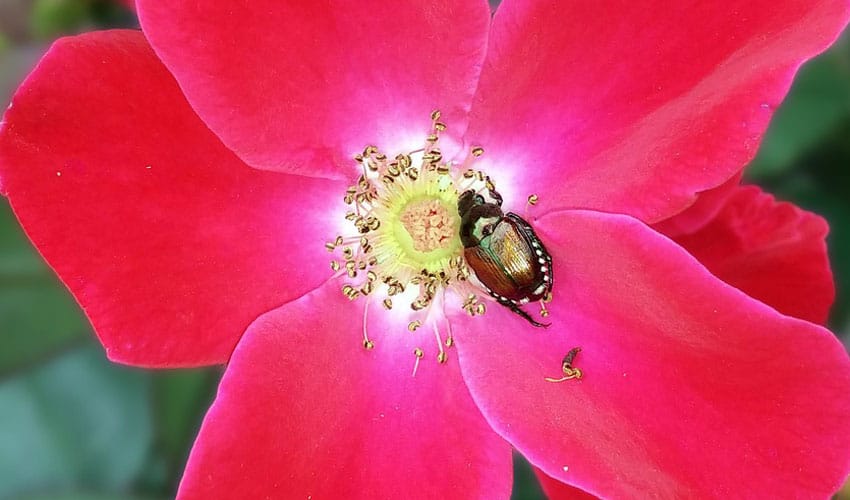
Japanese beetles love to eat rose blossoms!
Which Trees/Plants Do Japanese Beetles Like?
According to researchers at Ohio State University, Japanese beetles prefer some trees and shrubs over others. Below is a list of their favorite targets. If you have any of these plants on your property, keep close watch for signs of Japanese beetle damage.
- Japanese and Norway maple
- birch
- pin oak
- horse chestnut
- Rose of Sharon
- sycamore
- ornamental apple
- plum
- cherry
- roses (the beetles like rose blossoms)
- mountain ash
- willows
- lindens
- elms (these are also susceptible to Dutch elm disease)
- Virginia creeper
Trees & Shrubs That Are Rarely Attacked by Japanese Beetles
If you’re particularly concerned about Japanese beetle damage, you may want to consider planting trees and shrubs that are rarely attacked. In northeast Ohio, these include:
- red and silver maple
- holly
- boxwood
- euonymus
- flowering dogwood
- cedar
- juniper
- arborvitae
- red oak
- tulip tree
- magnolia
- red mulberry
- forsythia
- ash (although ash trees are vulnerable to Emerald Ash Borer infestation and may need special care)
- privet
- lilac
- spruce
- hydrangea
- yew
Don’t forget that we provide tree planting services if you decide to plant any of the trees or shrubs that Japanese beetles don’t like.
Contact Independent Tree
If you suspect Japanese beetles on your property, contact Independent Tree to schedule an inspection. We can confirm if you have Japanese beetles or another issue and can help you plan next steps.Recent Articles
Topics
About The Author

STAY IN THE LOOP
WITH OUR
LATEST UPDATES
"*" indicates required fields

